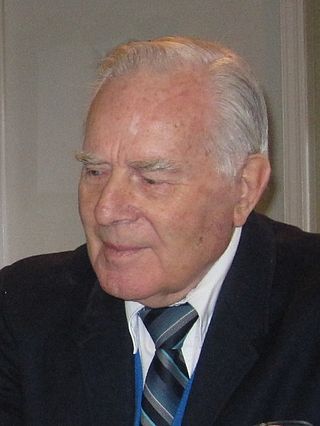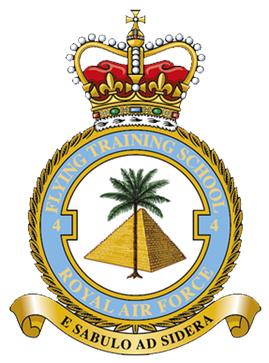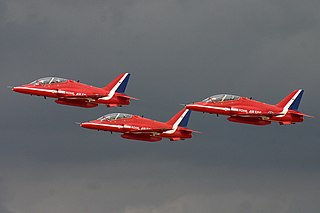
The Red Arrows, officially known as the Royal Air Force Aerobatic Team, is the aerobatics display team of the Royal Air Force (RAF) based at RAF Waddington. The team was formed in late 1964 as an all-RAF team, replacing a number of unofficial teams that had been sponsored by RAF commands.

Royal Air Force Leeming or more simply RAF Leeming is a Royal Air Force station located near Leeming, North Yorkshire, England. It was opened in 1940 and was jointly used by the RAF and the Royal Canadian Air Force (RCAF). Between 1950 and 1991, it operated mostly as a training base with Quick Reaction Force (QRF) Panavia Tornado F3 fighters based there in the latter stages of the Cold War and into the early 21st century. Since 2006, it has become the home of the deployable RAF communications cadre and the home of No. 135 Expeditionary Air Wing.

Royal Air Force Syerston, commonly known simply as RAF Syerston, is a Royal Air Force station in the parish of Flintham, near Newark, Nottinghamshire, England. Opened in 1940, it was used by the Royal Air Force (RAF) as a bomber base during the Second World War, operating Vickers Wellingtons, Avro Manchesters, and the Avro Lancaster heavy bombers. Post-war, it became home to Jet Provosts of the 2 Flying Training School. It is now home to the Royal Air Force Central Gliding School.

Royal Air Force Finningley or RAF Finningley was a Royal Flying Corps and Royal Air Force station at Finningley, in the Metropolitan Borough of Doncaster, South Yorkshire, England. The station straddled the historic county boundaries of both Nottinghamshire and the West Riding of Yorkshire.

The Red Pelicans were one of a number of aerobatics display teams of the Royal Air Force before the Red Arrows were selected to represent the service in 1965. The Red Pelicans flew the BAC Jet Provost aircraft.
No. 582 Squadron RAF was a bomber pathfinder squadron of the Royal Air Force during the Second World War.

Royal Air Force Newton or more simply RAF Newton is a former Royal Air Force station located 7 miles (11 km) east of Nottingham, Nottinghamshire and 10.7 miles (17.2 km) south west of Newark-on-Trent, Nottinghamshire, England. It was used briefly as a bomber base for squadrons to re-equip after the Battle of France and then as a flying training school during the Second World War and beyond until 2000.

Sherdils is the formation aerobatics display team of the Pakistan Air Force (PAF) & Royal Pakistan Air Scouts (RPAS). The Sherdil Team is based at the Pakistan Air Force Academy, Risalpur, Pakistan and at present, it consists of nine Karakoram K-8P aircraft.
Royal Air Force Wymeswold, or more simply RAF Wymeswold, is a former Royal Air Force satellite station located 3.5 miles (5.6 km) north-east of Loughborough, Leicestershire, England. The airfield is situated between Hoton, Wymeswold and Burton on the Wolds, lying in the current district of Charnwood.

No. 1417 Flight RAF was an independent flight of the Royal Air Force which existed between 1941 and 1993 at various times in a variety of roles. This Flight had probably the most interesting incarnations of all the independent aircraft flights of the Royal Air Force, introducing new technologies and operating complex fast jet aircraft in challenging and austere conditions, from the Arabian Peninsula to Central America.

Air Vice Marshal William "Paddy" Harbison,, was a British Royal Air Force (RAF) fighter pilot who served during the Second World War and the Korean War. He held senior command roles in the RAF and was the author of a noted technical report that evaluated the performance and tactics of jet combat during the Korean War.
Royal Air Force Bitteswell or more simply RAF Bitteswell is a former Royal Air Force satellite station located 2.0 miles (3.2 km) west of Lutterworth, Leicestershire and 6.1 miles (9.8 km) north of Rugby, Warwickshire, England.
The world record loop is the record for the highest number of aircraft to successfully complete an aerobatic loop while flying in formation. The current record is 22 aircraft. The record was set by the Royal Air Force aerobatic team, the Black Arrows, who successfully looped 22 Hawker Hunter jet aircraft every day of the September 1958 Society of British Aerospace Companies Farnborough Airshow, beating the previous record set by the Pakistan Air Force, who looped the 16 North American F-86 Sabres in February 1958. The record required the team to train pilots from other RAF squadrons. The team initially wanted to loop 20 aircraft, but additional aircraft were added to the formation in order to improve the formation's aesthetic appearance.
No. 6 Flying Training School RAF is a Flying Training School (FTS) within No. 22 (Training) Group of the Royal Air Force that delivers flying training to University Air Squadrons and Air Experience Flights.

No. 4 Flying Training School is a Royal Air Force military flying training school, which manages Advanced Fast Jet Training (AFJT) from its base at RAF Valley in Anglesey, Wales. Its role is to provide fast jet aircrew to the Operational Conversion Units for the RAF's jet attack aircraft, the Eurofighter Typhoon and the Lockheed Martin F-35 Lightning II.
The RAF College of Air Warfare is a former Royal Air Force flying training unit operational between 1962 and 1974. The unit traces its history back to 1942 as the Empire Central Flying School.

Flight Lieutenant Sean Cunningham was a Royal Air Force pilot on the Red Arrows aerobatics display team, who died when his ejection seat initiated whilst the aircraft he was in was stationary on the ground and he was conducting pre-flight checks. The incident occurred at the Red Arrows' home base, RAF Scampton in Lincolnshire, England. The initiation of the ejection seat was assumed to be by accident. The parachute on the seat did not deploy and Cunningham fell, still strapped to the seat, 220 feet (67 m) to his death 217 feet (66 m) away from the motionless aircraft. In January 2018, in the prosecution brought by the Health and Safety Executive, Martin-Baker, the manufacturers of the seat, pleaded guilty to a breach of health and safety law regarding Cunningham's death. On 23 February 2018, Martin-Baker were fined £1.1 million.
The Universities of Wales Air Squadron is a University Air Squadron of the Royal Air Force's Volunteer Reserve for students from Cardiff University, Cardiff Metropolitan University, Swansea University, University of Wales Trinity Saint David, University of South Wales, Glamorgan University, and Aberystwyth University. It was founded in 1963.

Flight Lieutenant Jon Egging was a Royal Air Force pilot on the Red Arrows aerobatics display team, who died after crashing into a field in Throop, Dorset. The incident occurred after a display at the Bournemouth Air Festival in Bournemouth, Dorset. It was determined that Flt Lt Egging was incapacitated due to the effects of g-force induced loss of consciousness until very shortly before impact. Egging was the first Red Arrows pilot to die in an aircraft crash in the 21st century, since Flt Lt Neil Duncan MacLachlan, in 1988.












